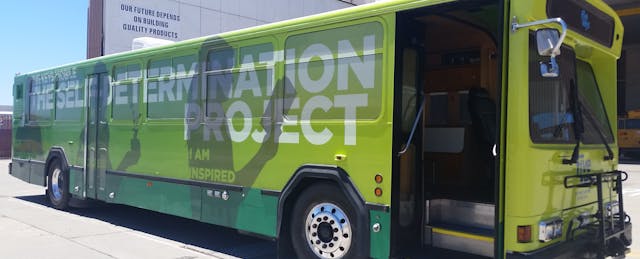How many students can you fit onto a school bus? Legally—72. But what if those students weren’t heading to school, but already there—desks, computers, steering wheel and all? In that case, Steve Good believes he can fit 15 adult learners at a time—up to 60 a day across four “classes”—with a teacher and an instructional aide (who also serves as the bus driver) to boot.
Good is the Executive Director of Five Keys, a network of brick-and-mortar learning centers and charter schools throughout the Bay Area. The organization made its mark in 2003 when they created the nation’s first county jail charter school.
Now, Good and his team are trying to solve a new problem: helping high school dropouts get their diplomas in the face of strict gang lines, rundown schools, and spotty internet. Their solution? Drive into high-crime, high-poverty neighborhoods and teach students where they’re at—all from the seats of a repurposed bus.

The idea for a mobile classroom started in 2015, as Good and his team become increasingly concerned about the conditions their students were learning in. He uses San Francisco to illustrate his point. “There are some places like [the community center] 1099 Sunnydale which provide a space to learn. But three blocks away, there’s a street students can’t cross because of gang territory,” Good explains. He says to solve the problem, Five Keys started sending teachers over to the nearby Willie Brown building, where students could safely attend. But again Good was not impressed.
“It was literally the last place you’d want to learn in,” he says. “There were puddles on the ground, students playing video games, paint peeling. So one day someone said, ‘What if we had a bus we could drive up and kids could go to school on a bus instead?’”
The idea caught on. A year later his team decided to make that a reality, transforming a bus into a classroom aimed to “provide dignity to all learners.”
The bus, part of an effort now called the Self-Determination Project, will travel to affordable housing units within San Francisco’s most high-poverty neighborhoods starting this August. It was made possible by two unexpected Bay Area allies: the San Francisco Municipal Transportation Agency, who donated the bus, and Google, who shelled out $100,000 to make the project possible.
Eventually, Good and his organization plan to expand beyond the city’s confines: first to the East Bay and surrounding enclaves, then Los Angeles, and someday, across the country. The question is: Will it work?

Five Key boasts a 15-year track record of helping some of the most in-need students get diplomas and GEDs through their accredited, California-approved curriculum and work development program. Currently, Five Keys serves 5,000 students each day—3,000 of them in the county jails and 2,000 in their community learning centers—99.9 percent of which are high school dropouts. The targeted approach seems to be working; while the state’s recidivism rate is 68 percent, only 28 percent of Five Keys students return to jail.
The organization hopes to replicate this success with the Self-Determination Project. But the decked-out bus, despite its inventive layout, presents its own set of obstacles. First and foremost: money.
“It’s a little cost intensive,” Good admits. “You need to fill it up with gas every day, pay for teachers, bus drivers, insurance. State apportionments”—the tax dollars Five Keys qualifies for as a public charter school—”are going to offset a lot of the cost, but there will still be tens of thousands of dollars to raise.”
There are also a host of logistical concerns. The bus is meant to help students unable to attend traditional schools get to class safely, but it doesn’t pick students up at home. Instead, it will pull into four set destinations a day where students can walk. Think of it like a portable classroom on wheels. With its bright green paint and life-affirming logo, though, it’s hardly the most conspicuous, raising concerns about safety.
Good agrees there is a need for security, but maintains the model provides a safer alternative to what's out there now. “There’s no more concern than a brick-and-mortar classroom,” he says. “The bus will park at a site students are already comfortable with, where they feel safe. We have cameras, cell phones.” And because the bus moves, students on both sides of the gang line can attend, albeit at different times.

So what about for students inside the bus? Standing in the bus on a balmy July day, it’s not hard to imagine with 15 grown students packed in, things could get uncomfortable. Add to that the fact that not every student will be learning at the same pace, or working at the same grade level, and it's clear whoever’s leading the class will need some Ms. Frizzle-level cool.
Again Good is reassuring. He says Five Keys has developed over 200 units to be delivered to students regardless of skill level, which are optimized for independent study and don’t rely on internet (though the bus will be kitted out with wi-fi and laptops). Five Keys understands what their students need: Flexibility, autonomy, and agency, and the program is designed to deliver that.
And in terms of that heat? “There’s an air conditioner,” Good says. “I just don’t think it’s working right now.”
Hopefully they’ll get it back in order by August.


